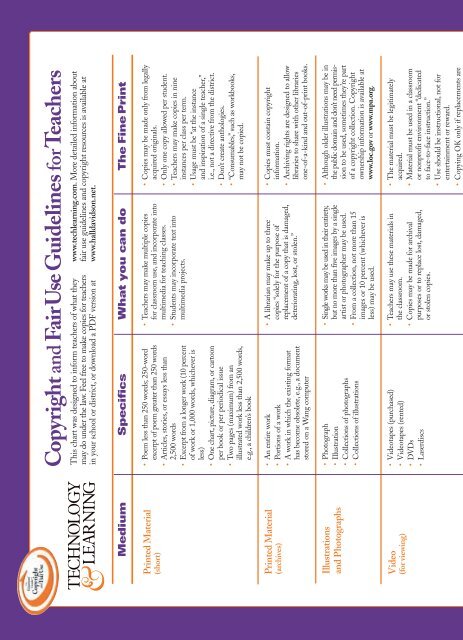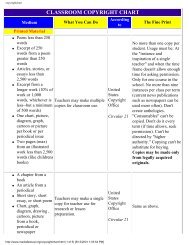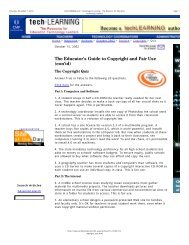Copyright Chart - Hall Davidson
Copyright Chart - Hall Davidson
Copyright Chart - Hall Davidson
Create successful ePaper yourself
Turn your PDF publications into a flip-book with our unique Google optimized e-Paper software.
<strong>Copyright</strong> and FairUse Guidelines forTeachers<br />
This chart was designed to inform teachers of what they<br />
may do under the law. Feel free to make copies for teachers<br />
in your school or district, or download a PDF version at<br />
www.techlearning.com. More detailed information about<br />
fair use guidelines and copyright resources is available at<br />
www.halldavidson.net.<br />
Medium Specifics What you can do The Fine Print<br />
Printed Material<br />
(short)<br />
• Poem less than 250 words; 250-word<br />
excerpt of poem greater than 250 words<br />
• Articles, stories, or essays less than<br />
2,500 words<br />
• Excerpt from a longer work (10 percent<br />
of work or 1,000 words, whichever is<br />
less)<br />
• One chart, picture, diagram, or cartoon<br />
per book or per periodical issue<br />
• Two pages (maximum) from an<br />
illustrated work less than 2,500 words,<br />
e.g., a children’s book<br />
• Teachers may make multiple copies<br />
for classroom use, and incorporate into<br />
multimedia for teaching classes.<br />
• Students may incorporate text into<br />
multimedia projects.<br />
• Copies may be made only from legally<br />
acquired originals.<br />
• Only one copy allowed per student.<br />
• Teachers may make copies in nine<br />
instances per class per term.<br />
• Usage must be “at the instance<br />
and inspiration of a single teacher,”<br />
i.e., not a directive from the district.<br />
• Don’t create anthologies.<br />
• “Consumables,” such as workbooks,<br />
may not be copied.<br />
Printed Material<br />
(archives)<br />
• An entire work<br />
• Portions of a work<br />
• A work in which the existing format<br />
has become obsolete, e.g., a document<br />
stored on a Wang computer<br />
• A librarian may make up to three<br />
copies “solely for the purpose of<br />
replacement of a copy that is damaged,<br />
deteriorating, lost, or stolen.”<br />
• Copies must contain copyright<br />
information.<br />
• Archiving rights are designed to allow<br />
libraries to share with other libraries<br />
one-of-a-kind and out-of-print books.<br />
Illustrations<br />
and Photographs<br />
• Photograph<br />
• Illustration<br />
• Collections of photographs<br />
• Collections of illustrations<br />
• Single works may be used in their entirety,<br />
but no more than five images by a single<br />
artist or photographer may be used.<br />
• From a collection, not more than 15<br />
images or 10 percent (whichever is<br />
less) may be used.<br />
• Although older illustrations may be in<br />
the public domain and don’t need permission<br />
to be used, sometimes they’re part<br />
of a copyright collection. <strong>Copyright</strong><br />
ownership information is available at<br />
www.loc.gov or www.mpa.org.<br />
Video<br />
(for viewing)<br />
• Videotapes (purchased)<br />
• Videotapes (rented)<br />
• DVDs<br />
• Laserdiscs<br />
• Teachers may use these materials in<br />
the classroom.<br />
• Copies may be made for archival<br />
purposes or to replace lost, damaged,<br />
or stolen copies.<br />
• The material must be legitimately<br />
acquired.<br />
• Material must be used in a classroom<br />
or nonprofit environment “dedicated<br />
to face-to-face instruction.”<br />
• Use should be instructional, not for<br />
entertainment or reward.<br />
• Copying OK only if replacements are
unavailable at a fair price or in a viable<br />
format.<br />
Video<br />
(for integration into<br />
multimedia or video<br />
projects)<br />
• Videotapes<br />
• DVDs<br />
• Laserdiscs<br />
• Multimedia encyclopedias<br />
• QuickTime Movies<br />
• Video clips from the Internet<br />
• Students “may use portions of lawfully<br />
acquired copyright works in their<br />
academic multimedia,” defined as 10<br />
percent or three minutes (whichever<br />
is less) of “motion media.”<br />
• The material must be legitimately<br />
acquired (a legal copy, not bootleg or<br />
home recording).<br />
• <strong>Copyright</strong> works included in multimedia<br />
projects must give proper attribution<br />
to copyright holder.<br />
Music<br />
(for integration into<br />
multimedia or video<br />
projects)<br />
• Records<br />
• Cassette tapes<br />
• CDs<br />
• Audio clips on the Web<br />
• Up to 10 percent of a copyright musical<br />
composition may be reproduced,<br />
performed, and displayed as part of a<br />
multimedia program produced by an<br />
educator or students.<br />
• A maximum of 30 seconds per musical<br />
composition may be used.<br />
• Multimedia program must have an<br />
educational purpose.<br />
Computer Software • Software (purchased)<br />
• Software (licensed)<br />
• Library may lend software to patrons.<br />
• Software may be installed on multiple<br />
machines, and distributed to users via<br />
a network.<br />
• Software may be installed at home and<br />
at school.<br />
• Libraries may make copies for archival<br />
use or to replace lost, damaged, or<br />
stolen copies if software is unavailable<br />
at a fair price or in a viable format.<br />
• Only one machine at a time may use<br />
the program.<br />
• The number of simultaneous users must<br />
not exceed the number of licenses; and<br />
the number of machines being used<br />
must never exceed the number licensed.<br />
A network license may be required for<br />
multiple users.<br />
• Take aggressive action to monitor that<br />
copying is not taking place (unless for<br />
archival purposes).<br />
Internet • Internet connections<br />
• World Wide Web<br />
• Images may be downloaded for<br />
student projects and teacher lessons.<br />
• Sound files and video may be downloaded<br />
for use in multimedia projects<br />
(see portion restrictions above).<br />
• Resources from the Web may not be<br />
reposted onto the Internet without<br />
permission. However, links to legitimate<br />
resources can be posted.<br />
• Any resources you download must have<br />
been legitimately acquired by theWeb site.<br />
Television<br />
• Broadcast (e.g., ABC, NBC, CBS,<br />
UPN, PBS, and local stations)<br />
• Cable (e.g., CNN, MTV, HBO)<br />
• Videotapes made of broadcast and<br />
cable TV programs<br />
• Broadcasts or tapes made from broadcast<br />
may be used for instruction.<br />
• Cable channel programs may be used<br />
with permission. Many programs may<br />
be retained by teachers for years—<br />
see Cable in the Classroom<br />
(www.ciconline.org) for details.<br />
• Schools are allowed to retain broadcast<br />
tapes for a minimum of 10 school days.<br />
(Enlightened rights holders,such asPBS’s<br />
ReadingRainbow, allow for much more.)<br />
• Cable programs are technically not<br />
covered by the same guidelines as<br />
broadcast television.<br />
Sources: United States <strong>Copyright</strong> Office Circular 21; Sections 107, 108, and<br />
110 of the <strong>Copyright</strong> Act (1976) and subsequent amendments, including the<br />
Digital Millennium <strong>Copyright</strong> Act; Fair Use Guidelines for Educational<br />
Multimedia; cable systems (and their associations); and <strong>Copyright</strong> Policy and<br />
Guidelines for California’s School Districts, California Department of Education.<br />
Note: Representatives of the institutions and associations who helped to draw up<br />
many of the above guidelines wrote a letter to Congress dated March 19, 1976, stating:<br />
“There may be instances in which copying that does not fall within the guidelines<br />
stated [above] may nonetheless be permitted under the criterion of fair use.”









